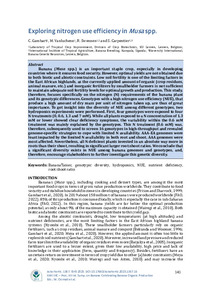| dc.contributor.author | Gambart, C. |
| dc.contributor.author | Vanluchene, M. |
| dc.contributor.author | Swennen, R. |
| dc.contributor.author | Carpentier, S.C. |
| dc.date.accessioned | 2023-06-01T08:59:48Z |
| dc.date.available | 2023-06-01T08:59:48Z |
| dc.date.issued | 2023-05 |
| dc.identifier.citation | Gambart, C., Vanluchene, M., Swennen, R. & Carpentier, S.C. (2023). Exploring nitrogen use efficiency in Musa spp. Acta Horticulturae, 1367, 141-150. |
| dc.identifier.issn | 0567-7572 |
| dc.identifier.uri | https://hdl.handle.net/20.500.12478/8186 |
| dc.description.abstract | Banana (Musa spp.) is an important staple crop, especially in developing countries where it ensures food security. However, optimal yields are not obtained due to both biotic and abiotic constraints. Low soil fertility is one of the limiting factors in the East African highlands, as the currently applied amount of organic (crop residues, animal manure, etc.) and inorganic fertilizers by smallholder farmers is not sufficient to maintain adequate soil fertility levels for optimal growth and production. This study, therefore, focuses specifically on the nitrogen (N) requirements of the banana plant and its genotypic differences. Genotypes with a high nitrogen use efficiency (NUE), that produce a high amount of dry mass per unit of nitrogen taken up, are thus of great importance. To get insight into the diversity of NUE among different genotypes, two hydroponics experiments were performed. First, four genotypes were exposed to four N treatments (0, 0.6, 1.3 and 7 mM). While all plants exposed to a N concentration of 1.3 mM or lower showed clear deficiency symptoms, the variability within the 0.6 mM treatment was mainly explained by the genotypes. This N treatment (0.6 mM) was, therefore, subsequently used to screen 16 genotypes in high-throughput and revealed genome-specific strategies to cope with limited N availability. AAA-EA genomes were least impacted by the limited N availability in both root and shoot. AAA genomes were most affected. Nevertheless, all N deficient plants invested in an absolute way more in roots than their shoot, resulting in significant larger root:shoot ratios. We conclude that a significant diversity exists in NUE among banana genomes and genotypes, and, therefore, encourage stakeholders to further investigate this genetic diversity. |
| dc.description.sponsorship | CGIAR Trust Fund |
| dc.format.extent | 141-150 |
| dc.language.iso | en |
| dc.subject | Bananas |
| dc.subject | Food Security |
| dc.subject | Genotypes |
| dc.subject | Diversity |
| dc.subject | Hydroponics |
| dc.subject | Nitrogen-Use Efficiency |
| dc.subject | Nutrient Deficiencies |
| dc.subject | East Africa |
| dc.title | Exploring nitrogen use efficiency in Musa spp. |
| dc.type | Journal Article |
| cg.contributor.crp | Roots, Tubers and Bananas |
| cg.contributor.affiliation | Katholieke Universiteit Leuven |
| cg.contributor.affiliation | International Institute of Tropical Agriculture |
| cg.contributor.affiliation | Bioversity International |
| cg.coverage.region | ACP |
| cg.coverage.region | Europe |
| cg.coverage.country | The United Kingdom |
| cg.coverage.hub | Eastern Africa Hub |
| cg.researchtheme | Biotech and Plant Breeding |
| cg.identifier.bibtexciteid | GAMBART:2023 |
| cg.authorship.types | CGIAR and advanced research institute |
| cg.iitasubject | Agronomy |
| cg.iitasubject | Banana |
| cg.iitasubject | Food Security |
| cg.iitasubject | Plant Breeding |
| cg.iitasubject | Plant Production |
| cg.journal | Acta Horticulturae |
| cg.notes | Published online: May 2023 |
| cg.accessibilitystatus | Limited Access |
| cg.reviewstatus | Peer Review |
| cg.usagerightslicense | Copyrighted; all rights reserved |
| cg.targetaudience | Scientists |
| cg.identifier.doi | https://doi.org/10.17660/actahortic.2023.1367.16 |
| cg.iitaauthor.identifier | Rony Swennen: 0000-0002-5258-9043 |
| cg.futureupdate.required | No |
| cg.identifier.volume | 1367 |

